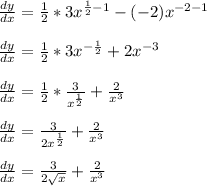Answer:
Explanation:
Before we differentiate, let us assign a variable to the function. Let y be equal to the function i.e let y = 3√x -2/x²
In differentiation if
 , then
, then
 where n is a constant and dy/dx means we are differentiating the function y with respect to x.
where n is a constant and dy/dx means we are differentiating the function y with respect to x.
Applying the formula o the question given;

On differentiating the resulting function;

To combine the terms, we will add up by finding their LCM.
